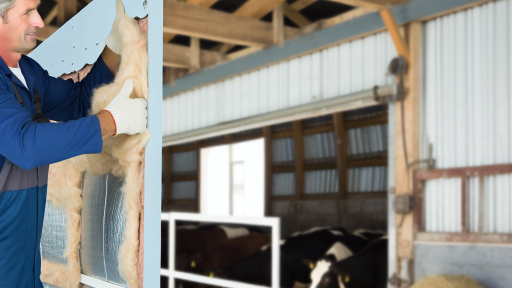Understanding the Benefits of Integrating Exotic Livestock into Farm Systems
Diversity and Resilience
Integrating exotic livestock enhances genetic diversity on the farm.
This diversity increases resilience against diseases.
Furthermore, it strengthens the overall health of the farm ecosystem.
Economic Viability
Exotic livestock can provide new income streams for farmers.
They often command higher market prices due to their uniqueness.
Additionally, they can attract niche markets and specialty buyers.
Resource Utilization
Exotic livestock may offer unique benefits in resource utilization.
For instance, some breeds are more efficient at converting feed into meat.
This efficiency can reduce feed costs and overall waste.
Improved Farm Sustainability
Integrating exotic species can lead to improved sustainability practices.
Their different grazing habits can enhance pasture management.
This can help reduce soil erosion and promote land restoration.
Enhancing Biodiversity
Exotic livestock contribute to the overall biodiversity on a farm.
This increased biodiversity can support local wildlife populations.
Moreover, it enhances the farm’s ecological balance and health.
Transform Your Agribusiness
Unlock your farm's potential with expert advice tailored to your needs. Get actionable steps that drive real results.
Get StartedAttracting Tourism Opportunities
Farms with exotic livestock can attract tourists and visitors.
This can provide additional revenue through farm tours and educational programs.
Moreover, it promotes awareness of sustainable farming practices.
Identifying Suitable Exotic Livestock Species for Your Local Environment
Assessing Local Climate Conditions
The first step is understanding your local climate.
Different livestock species thrive in varying climates.
For instance, tropical breeds prefer warm, humid conditions.
In contrast, some exotic species can withstand colder temperatures.
Evaluate temperature ranges and seasonal changes to make informed decisions.
Evaluating Soil and Water Resources
Next, consider your soil type and water availability.
Some exotic livestock require specific forage and habitat types.
Assess whether you have the necessary resources for their care.
Water quality and quantity are crucial for maintaining health.
Analyze your farm’s capacity to support these species.
Researching Disease Resistance
Disease resistance plays a significant role in livestock selection.
Some exotic breeds may not adapt well to local diseases.
Conduct research on disease prevalence in your area.
Choose species known for their resilience against common illnesses.
This strategy helps minimize health risks and losses.
Understanding Market Demand
Consider the market demand for different exotic livestock.
Identify what sells well in your local area or beyond.
Engage with local suppliers and customers to gauge interest.
This step ensures you choose species that are financially viable.
Assessing Local Regulations
Don’t overlook the importance of local regulations.
Research zoning laws and livestock ownership rules.
Showcase Your Farming Business
Publish your professional farming services profile on our blog for a one-time fee of $200 and reach a dedicated audience of farmers and agribusiness owners.
Publish Your ProfileEnsure that your selected species comply with these regulations.
Understanding legal aspects protects you from potential penalties.
Connecting with Local Experts
Finally, connect with local agricultural experts.
They can provide valuable insights into exotic livestock integration.
Attend workshops and seminars to learn more about sustainable practices.
Networking also leads to collaborations with experienced farmers.
This support can significantly improve your success rate.
Assessing the Economic Viability of Exotic Livestock Integration
Understanding the Current Market
The exotic livestock market has been consistently evolving.
Agricultural producers need to conduct thorough market research.
Identifying popular exotic species can inform better decisions.
Engaging local farmers can provide valuable insights on trends.
Investigating pricing strategies will help maximize profitability.
Cost-Benefit Analysis
Performing a cost-benefit analysis is crucial before integrating exotic livestock.
Calculate initial investment costs such as purchase and equipment.
Consider ongoing expenses like feed, healthcare, and maintenance.
Assess potential revenue from selling exotic products.
Also, analyze seasonal fluctuations in product demand.
Potential Risks and Challenges
Integrating exotic livestock comes with unique risks.
Market acceptance can vary significantly by region.
Health concerns exist for both animals and humans.
Regulatory compliance is essential to avoid legal issues.
Additionally, exotic species may experience higher mortality rates.
Profitability and Sustainability
Sustainable practices enhance the long-term profitability of livestock integration.
Evaluate how exotic livestock can improve farm diversity.
Consider rotational grazing and diversified feeding strategies.
Analyze potential environmental impacts on local ecosystems.
Moreover, sustainable practices can attract eco-conscious consumers.
Long-Term Planning and Strategy
Develop a long-term strategy for integrating exotic livestock.
Set short-term and long-term goals for your farm operations.
Regularly review and adjust your integration strategy as needed.
Engage with industry experts for ongoing advice and insights.
Finally, maintain flexibility to adapt to market changes.
See Related Content: Essential Breeding Strategies for Livestock Farmers
Creating Sustainable Management Practices for Exotic Livestock
Assessing Your Farm’s Needs
Begin with a thorough assessment of your farm’s current resources.
Consider the existing land, water, and feed availability.
This will help you decide which exotic livestock suits your system.
Understanding the Species
Research the specific needs of the exotic animals you wish to incorporate.
Each species has unique dietary and environmental requirements.
Proper understanding minimizes health issues and improves productivity.
Integrating Exotic Livestock
Introduce exotic livestock gradually into your existing systems.
Showcase Your Farming Business
Publish your professional farming services profile on our blog for a one-time fee of $200 and reach a dedicated audience of farmers and agribusiness owners.
Publish Your ProfileStart with a small number to monitor their adaptation.
This approach helps you manage stress for both the animals and your farm.
Creating a Balanced Ecosystem
Ensure that the new species complement your existing livestock.
Assess their role in the ecosystem for optimal coexistence.
For example, some species can improve soil health or pest control.
Developing Feeding Strategies
Establish effective feeding strategies tailored to the exotic species.
Focus on high-quality forage and supplements as needed.
Consult with a livestock nutritionist for better results.
Health and Welfare Management
Regular health checks are crucial for maintaining livestock welfare.
Keep up-to-date on vaccinations and preventive care protocols.
Additionally, create a stress-free environment to enhance well-being.
Monitoring and Evaluating Performance
Regularly monitor the performance and health of your exotic livestock.
Use this data to adjust management practices as necessary.
This continuous evaluation helps in understanding their impact on the farm.
Community and Support Networks
Engage with local farming communities and online forums.
Sharing experiences can provide valuable insights and recommendations.
Consider establishing support networks for exotic livestock farmers.
Delve into the Subject: Feeding Strategies for Exotic Livestock
Understanding Regulations and Compliance for Keeping Exotic Animals
Importance of Regulations
Regulations ensure the safety of both exotic animals and farm operations.
They help prevent the spread of diseases among animals and humans.
Additionally, they protect native wildlife from invasive species.
Local and National Laws
Each state and country has specific laws governing exotic animals.
It is crucial to research local and national requirements.
Consult local agricultural departments to gather accurate information.
Online databases provide resources for understanding these laws.
Permits and Licensing
Acquiring the proper permits is essential before introducing exotic animals.
Research the types of permits required for your location.
Some animals may require special licenses or registrations.
Ensure your paperwork is organized for inspections and audits.
Inspections and Compliance Checks
Regular inspections help maintain compliance with established regulations.
Be prepared for unannounced visits from local authorities.
Document all care practices and facilities for easy reference.
Compliance checks often involve health and safety protocols.
Animal Welfare Standards
Adhering to animal welfare standards is vital for ethical farming.
Familiarize yourself with guidelines for housing and care.
Provide adequate space, food, and medical care for exotic animals.
Regular training and updates on animal welfare are recommended.
Community Engagement and Reporting
Engaging with the local community fosters support for your farm.
Report any issues related to exotic animal care promptly.
Join local farming organizations for resources and advocacy.
Showcase Your Farming Business
Publish your professional farming services profile on our blog for a one-time fee of $200 and reach a dedicated audience of farmers and agribusiness owners.
Publish Your ProfileTransparency helps build trust and encourages best practices.
Find Out More: Optimal Layouts For Livestock Housing Units

Training and Educating Farm Staff on Exotic Livestock Care
The Importance of Specialized Knowledge
Specialized knowledge is essential for caring for exotic livestock.
Such animals often have unique needs compared to traditional livestock.
Training ensures that all care practices are appropriate for each species.
Developing a Robust Training Program
A well-structured training program helps farm staff gain necessary skills.
Start by identifying the specific needs of each exotic species.
Then, create training modules tailored to those needs.
Incorporating hands-on experiences enhances the learning process.
Utilizing Expert Resources
Consult experts to provide in-depth training for your staff.
Invite veterinarians with experience in exotic species to conduct workshops.
These workshops can cover health care, feeding, and habitat needs.
Implementing Ongoing Education
Ongoing education is vital in maintaining updated knowledge.
Regular workshops and training refreshers keep staff informed.
Consider creating an online resource repository for staff access.
Encouraging Team Involvement
Involve staff in the training process to encourage ownership of their roles.
Team discussions can also promote sharing of best practices.
Additionally, establish a mentorship program to pair experienced staff with newcomers.
Assessing Knowledge and Skills
Regular assessments help gauge the effectiveness of the training program.
Consider quizzes or practical evaluations to measure understanding.
Feedback from staff can also highlight areas for improvement.
Creating a Safe Learning Environment
A safe and supportive atmosphere encourages learning and growth.
Promote an open-door policy for staff to ask questions without hesitation.
Provide access to necessary resources to facilitate learning.
Gain More Insights: Preventing Diseases in Exotic Livestock
Developing a Marketing Strategy for Exotic Livestock Products
Understanding Your Market
Begin by researching your target market.
Identify the consumers interested in exotic livestock products.
This can include restaurants, specialty shops, and health-conscious individuals.
Conduct surveys to gather consumer preferences and demand.
Next, analyze your competition.
Examine other farms that offer similar products.
Assess their strengths and weaknesses.
In doing so, you can spot opportunities to distinguish your farm.
Creating a Unique Selling Proposition
Define what makes your products unique.
This could be the breed of livestock or the farming method used.
Emphasize quality, sustainability, or local sourcing in your messaging.
Consider collaborating with chefs to develop signature dishes.
These partnerships can enhance your farm’s visibility.
Building an Online Presence
Establish a website showcasing your farm and products.
Include high-quality images and engaging content.
Showcase Your Farming Business
Publish your professional farming services profile on our blog for a one-time fee of $200 and reach a dedicated audience of farmers and agribusiness owners.
Publish Your ProfileUtilize social media platforms to connect with potential customers.
Regularly share updates on farm activities and new products.
Engage with your audience through comments and messages.
Implementing Direct Sales Strategies
Consider participating in local farmers’ markets.
Direct sales allow consumers to interact with your product firsthand.
Offer samples to entice potential buyers.
Additionally, explore subscription models for regular deliveries.
Membership programs can foster customer loyalty over time.
Networking and Collaboration
Join local farming and livestock associations.
These networks can provide valuable connections and resources.
Attend trade shows and expos to showcase your products.
Collaborate with local businesses for cross-promotion.
Building relationships can lead to new opportunities.
Tracking and Analyzing Performance
Monitor sales and customer feedback regularly.
This helps you understand market trends and consumer preferences.
Utilize analytics tools to assess your online marketing efforts.
Adjust your strategy based on performance data.
Continuous improvement is essential for success.
Evaluating the Environmental Impact of Exotic Livestock on the Farm Ecosystem
Understanding Exotic Livestock
Exotic livestock can offer new opportunities for farmers seeking diversification.
They differ from traditional livestock in many ways, including their habitats and dietary needs.
Understanding their characteristics is crucial before integrating them into existing systems.
Potential Positive Impacts
Exotic livestock can enhance biodiversity on farms.
They may contribute to soil health through unique grazing patterns.
Additionally, they can attract different pollinators and improve ecosystem resilience.
Potential Negative Impacts
Conversely, these animals can pose environmental risks.
They may outcompete local species for food and space.
Furthermore, they can introduce diseases that affect native wildlife and domestic stocks.
Management practices must account for these potential threats.
Assessing Resource Use
Resource consumption varies among different breeds of exotic livestock.
Water usage can be significantly higher compared to traditional livestock.
Conducting an analysis of feed requirements is also essential.
Efficient resource use minimizes negative environmental impacts.
Evaluating Carbon Footprint
The carbon footprint of exotic livestock is a crucial factor to consider.
Some species may produce higher greenhouse gas emissions.
Therefore, understanding their manure management practices can mitigate impacts.
Farmers can adopt sustainable practices to lower overall emissions.
Integrating with Local Ecosystems
Integration requires a careful approach to balance ecosystems.
Monitoring and evaluating interactions with native species is essential.
Farmers should consider local regulations regarding exotic livestock.
Collaboration with environmental agencies can provide beneficial guidance.
Showcase Your Farming Business
Publish your professional farming services profile on our blog for a one-time fee of $200 and reach a dedicated audience of farmers and agribusiness owners.
Publish Your ProfileLong-term Sustainability
Ensuring long-term sustainability begins with careful planning.
This includes assessing possible changes in land use and ecosystems over time.
Farmers must adopt adaptive management strategies for evolving conditions.
Evaluating both economic and environmental outcomes helps foster success.
Additional Resources
Management of Plant and Arthropod Pests by Deer Farmers in Florida
Eastern Oregon Agricultural Research Center | Burns Station …




